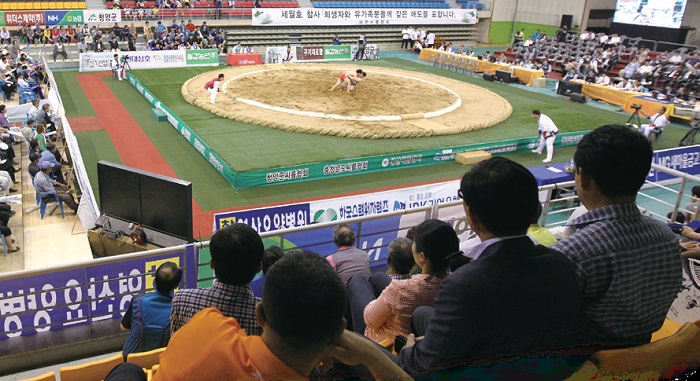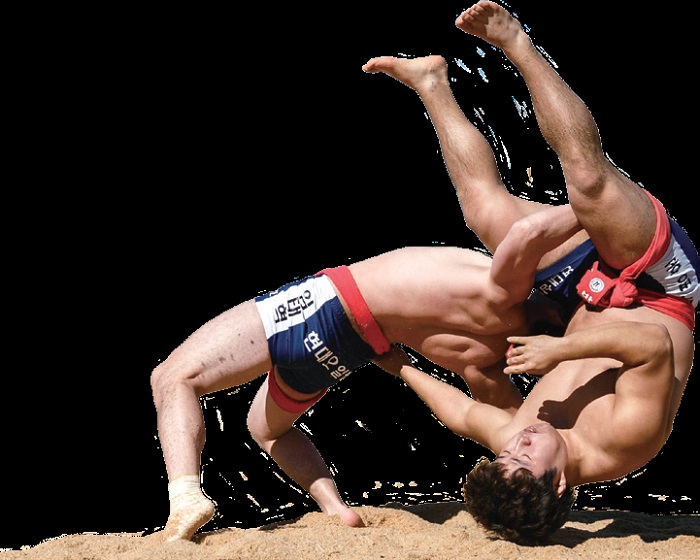-
 Korea.net's 24-hour YouTube channel
Korea.net's 24-hour YouTube channel- NEWS FOCUS
- ABOUT KOREA
- EVENTS
- RESOURCES
- GOVERNMENT
- ABOUT US
View this article in another language
- 한국어
- English
- 日本語
- 中文
- العربية
- Español
- Français
- Deutsch
- Pусский
- Tiếng Việt
- Indonesian
Four Korean ssireum wrestlers performed on Switzerland’s Gornergrat ridge, directly in front of the iconic peak of the Matterhorn, as part of the Swiss Alpine wrestling festival from Sept. 12–14. Demonstrating the essence of their sport before Swiss spectators, the wrestlers received a warm welcome from the fans.
Spectators were even offered 1,000 euros if they could hold out against a ssireum wrestler for more than five seconds. Three took the challenge. Not one succeeded.
The trip to Switzerland was a highlight for a sport that has had its ups and downs in recent decades. Ssireum, or Korean traditional wrestling, used to be one of the most popular sports in the country. Competition from other sports, however, has eaten away at both its talent pool and fan base. In spite of these hurdles, the sport continues on, as a younger generation tests its mettle in the ring.

Sport of the Masses
Nobody’s quite sure when the sport of ssireum began, but evidence suggests that Koreans have been practicing it—or something like it, at least— since ancient times. To be sure, similar sports have been practiced in nearby countries like Mongolia and Japan for centuries. Wall paintings found in Goguryeo tombs in Manchuria, for example, depict athletes engaging in a wrestling match very similar to ssireum. The 14th century Goryeo ruler King Chunghye was, according to historical documents, such a big fan of ssireum that he ordered soldiers to wrestle one another during a banquet.
The sport really took off during Joseon times, however. During this time, ssireum became a veritable staple of Korean village life. The Dano holiday, celebrated on the fifth day of the fifth lunar month, was marked by village ssireum tournaments, but tournaments were held at other times, too, including the third day of the third lunar month, the eighth day of the eighth fourth lunar month and Buddhist All Souls’ Day. One of the most iconic folk paintings of the Joseon era, Kim Hong-do’s “Sangbak,” is a graphic, 18th century depiction of a village ssireum match. These events were accompanied by music and much merriment, and victorious athletes were typically given a bull as a prize, which was not only an incredibly valuable source of power in pre-modern Korea’s agricultural society but also a symbol of strength.
The popularity of the sport continued through the 20th century. In the 21st century, however, ssireum has had to compete with other contact sports for its spectators at matches. Falling popularity has led some ssireum athletes, most notably the giant former champion Choi Hongman, to seek greener pastures in other sports such as mixed martial arts.

Strength and Technique
While ssireum is ultimately a test of strength, the sport is designed in such a way that the chance of injury is very low. Wrestlers square off in a circular, sand-filled ring and, in contrast with the Japanese wrestling sport of sumo, the athletes are not allowed to strike one another. Instead, ssireum athletes grab a belt that wraps around the waist and thigh of the opponent, with the goal of forcing any part of the opponent’s body above the knee to the ground. Brute muscular strength is important, of course, but so is taking advantage of an opponent’s movements to get them off-balance.
While many of Korea’s top athletes now take their skills to other more popular (and more lucrative) sports, others stick with tradition. Kim Min-seong, wrestling for Gumi City Hall, scored a victory in the Presidential Ssireum Tournament held in Iksan, Jeollabuk-do, in August. * Article from Korea Magazine (November 2014)
Spectators were even offered 1,000 euros if they could hold out against a ssireum wrestler for more than five seconds. Three took the challenge. Not one succeeded.
The trip to Switzerland was a highlight for a sport that has had its ups and downs in recent decades. Ssireum, or Korean traditional wrestling, used to be one of the most popular sports in the country. Competition from other sports, however, has eaten away at both its talent pool and fan base. In spite of these hurdles, the sport continues on, as a younger generation tests its mettle in the ring.

Competitors in the 80 kg division at the Dano Jangsa Ssireum Competition at Cheongyang Stadium in Chungcheongnam-do © Yonhap News
Sport of the Masses
Nobody’s quite sure when the sport of ssireum began, but evidence suggests that Koreans have been practicing it—or something like it, at least— since ancient times. To be sure, similar sports have been practiced in nearby countries like Mongolia and Japan for centuries. Wall paintings found in Goguryeo tombs in Manchuria, for example, depict athletes engaging in a wrestling match very similar to ssireum. The 14th century Goryeo ruler King Chunghye was, according to historical documents, such a big fan of ssireum that he ordered soldiers to wrestle one another during a banquet.
The sport really took off during Joseon times, however. During this time, ssireum became a veritable staple of Korean village life. The Dano holiday, celebrated on the fifth day of the fifth lunar month, was marked by village ssireum tournaments, but tournaments were held at other times, too, including the third day of the third lunar month, the eighth day of the eighth fourth lunar month and Buddhist All Souls’ Day. One of the most iconic folk paintings of the Joseon era, Kim Hong-do’s “Sangbak,” is a graphic, 18th century depiction of a village ssireum match. These events were accompanied by music and much merriment, and victorious athletes were typically given a bull as a prize, which was not only an incredibly valuable source of power in pre-modern Korea’s agricultural society but also a symbol of strength.
The popularity of the sport continued through the 20th century. In the 21st century, however, ssireum has had to compete with other contact sports for its spectators at matches. Falling popularity has led some ssireum athletes, most notably the giant former champion Choi Hongman, to seek greener pastures in other sports such as mixed martial arts.

Korean ssireum wrestlers battle it out on Gornergrat Mountain above Zermatt, Switzerland, in September. © Yonhap News
Strength and Technique
While ssireum is ultimately a test of strength, the sport is designed in such a way that the chance of injury is very low. Wrestlers square off in a circular, sand-filled ring and, in contrast with the Japanese wrestling sport of sumo, the athletes are not allowed to strike one another. Instead, ssireum athletes grab a belt that wraps around the waist and thigh of the opponent, with the goal of forcing any part of the opponent’s body above the knee to the ground. Brute muscular strength is important, of course, but so is taking advantage of an opponent’s movements to get them off-balance.
While many of Korea’s top athletes now take their skills to other more popular (and more lucrative) sports, others stick with tradition. Kim Min-seong, wrestling for Gumi City Hall, scored a victory in the Presidential Ssireum Tournament held in Iksan, Jeollabuk-do, in August. * Article from Korea Magazine (November 2014)
Most popular
- China warmly welcomes first Korea-born giant panda Fu Bao
- First hearing-impaired K-pop act hopes for 'barrier-free world'
- Novelist Hwang's 'Mater 2-10' shortlisted for Int'l Booker Prize
- Expats could account for 7% of population in 20 years: report
- Nat'l Fire Agency picks 137 elite staff for deployment abroad













